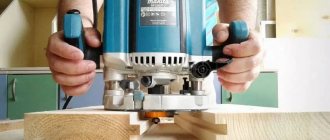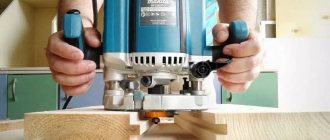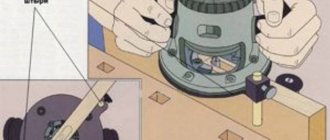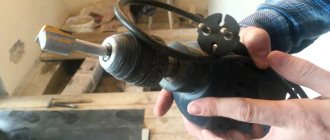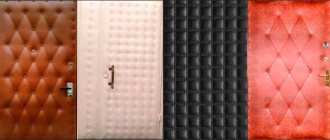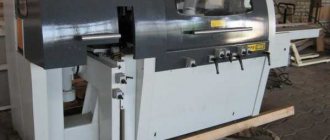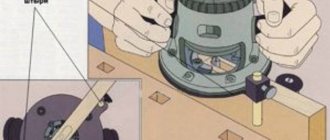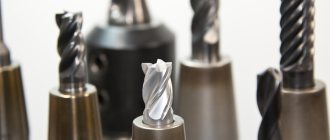23.03.2020
- Design and operating principle
- Classification of cutters: by what parameters
- Types of cutters for metal
- Classification of cutters according to some characteristics
- Nuances of choice
- Storage and operation rules
- Wide range of milling machine capabilities
During milling metalworking, it is important what type of metal cutter the master has chosen. In the article we will talk about the numerous varieties and features of their use - both a beginner and a professional will need this for repetition.
Wood cutter for a manual router - what is it and what is its purpose
A cutter for a manual electric router is a small-sized cutting tool. Consists of three simple parts:
- shank;
- supporting body;
- cutting knives fixed in the supporting body.
A lot depends on the quality of the cutter. As experienced craftsmen say, it is not so important what kind of router is used, what matters is the quality of the cutter.
However, it is better to work with a high-quality, convenient router. During operation, the cutter rotates at enormous speeds, due to which cleanliness, speed and quality of processing are achieved. The electric motor of the milling cutter, through an overdrive gearbox, gives the cutter a rotation speed from 10,000 to 30,000 rpm. The more revolutions the router can produce, the better.
Briefly about the main thing
The milling cutter is the main cutting tool of a manual milling machine. Among its main parts are:
- Cutting part.
- Shank.
- Additional components.
It is used for various roughing and finishing tasks in woodworking - cutting grooves, trimming, forming interlocking joints, cutting, decorative design, etc. Milling cutters for wood processing are classified primarily according to a number of parameters such as the diameter and length of the tail, the type of design, the material from which the cutting edge is made and the method of sharpening it.
In addition, according to the method of processing the material, they differ into end, edge, groove, combined and figured. Each modification has its own characteristics and nuances of application.
Type of shank diameter
The shank of a cutter is a round metal rod, the same as that of a drill. But unlike a drill press, drill or screwdriver, the cutter shank is clamped not in a 3-jaw chuck, but in a collet clamp (collet).
This clamp is much more compact than the chuck; it is easier to tighten one nut than the jaws on the chuck with a special wrench. This is important given the design of this tool. The disadvantage of this clamp is that you can only use shanks that are suitable in size. This differs from a chuck, in which you can clamp the shank of a drill with a size of, for example, from 1 to 10 mm.
Modern routers use collets to clamp three main shank standards: 6 mm, 8 mm, 10 mm and 12 mm. Many models come with replaceable collets. For example, for 6 and 8 mm shanks.
The cutter rotates at enormous speeds, so it must always be securely tightened when working. If the collet clamp fails, you cannot use the tool, it is dangerous.
The collet is tightened with a special wrench included in the kit or with another spanner (open-end) wrench of similar size. To tighten and unscrew, the shaft is locked either by pressing the lock provided in the design, or with another key, if the shaft has edges for a second key for fixing.
Fixation with a second key is more reliable, since the internal latches sometimes break off. Therefore, on high-quality branded models, key fasteners are often used. This is an advantage, not a disadvantage.
The collet nut is tightened with force until it stops, but without unnecessary zeal, so as not to strip the threads, or the edges of the nut and the key.
Functionality
Initially, cutters were used in dentistry and were intended for dental treatment. Only the forms in demand for nail treatment came into the nail industry.
Of the huge number of cutters on the market, each can be used at one or another stage of a manicure or pedicure. But a number of attachments are distinguished by increased functionality and can be used at several stages. Some of them can complete the entire manicure procedure in the hands of a skilled manicurist. Let's look at the most functional cutters for removing coatings and working with skin and nail plates.
Coating cutters
Any attachments with teeth that have indentations between them will do. For gel polish, fine teeth are no more than 1 mm, and for acrylic and gel, deep teeth. This is necessary in order not to saw through areas with an increased risk of sawing, for example, the cuticle, lateral sinuses. Fine teeth leave behind a smooth surface. It is worth focusing not on the speed of material removal, which is provided by deep teeth, but on the safety of removal.
If we take cutters with large threads larger than 1 mm, then even with high-quality material removal, grooves will remain. Next, they will need to be additionally polished with buffs and files, which will require additional time from the master.
The teeth have a direction - clockwise or counterclockwise. There are also reversible teeth, “looking” in both directions at the same time. They are suitable for left-handers and right-handers.
The cone-shaped nozzle is the best for removing material from nails. It provides the largest contact area and the highest processing efficiency.
Based on the material of manufacture, it is worth considering the following cutters for removal:
- Carbide cutters are similar to metal cutters, but they wear out quickly. They are enough for 40-50 material removals. The cost of each varies from 100 to 600 rubles from top manufacturers.
- Steel cutters are more durable and wear-resistant. They differ from carbide ones only in the shade of the metal. Their cost starts from 500-600 rubles.
- Ceramic cutters are the most durable and durable. They last for 2-3 years.
There are metal cutters with spraying. This can be plating with galvanic gold or titanium. A distinctive feature of these attachments is the ability to monitor wear. When the coating wears off, it’s time to change the cutter.
Titanium-coated cutters for material removal have a blue iridescent surface. This coating is stronger than electroplating gold. The nozzles are highly wear resistant.
Step-by-step analysis of hardware manicure
Cutters for working with skin and nail plates
The first category is diamond cutters. They are suitable for manicures, cleaning sinuses, side rollers and cuticle areas.
Different abrasives are designed for different functions.
Diamond cutter categories:
- galvanic;
- sintered monolithic.
Galvanic cutters feature a galvanic base, a metal onto which an adhesive layer is applied and an abrasive is sprayed. This results in a grainy surface. Depending on how these coatings are sunk into the adhesive base, the nozzle will either process well, or quickly become clogged and worn out during operation.
It is best when the spraying is half recessed into the adhesive base. Diamond galvanic cutters last from 5 to 40 manicures, depending on whether they are used to process the coating or just the skin. Economical in cost - from 50 to 650 rubles, depending on the manufacturer and the quality of spraying. They are enough for 1-4 weeks of work with a dense flow of clients.
The marking of galvanic attachments starts from the white notch.
- White notch is rare and practically useless in the daily work of a craftsman. The nozzle is more suitable for polishing.
- Yellow diamond cutter - for working out, polishing the skin, removing remnants of pterygium in sensitive skin.
- Red abrasive is a universal tool for all stages of manicure. The most common use is internal cleaning of pterygium in the lateral sinuses and from the surface of the nail plate.
- Blue abrasive - only for external areas of the skin - cutting the cuticle and processing the side rollers. Not on sensitive thin skin.
- Green abrasive - coarse - is rarely used in manicure. More often - in pedicure for treating calluses and rough skin of the side ridges.
- The black diamond cutter is the roughest and most aggressive. Not for manicure. Can only be used to remove small areas of gel polish in hard-to-reach areas.
The second category is monolithic or sintered diamond cutters. Serve from 2 to 10 years. Expensive, the price can reach 8,000 rubles.
- Sintered is an attachment in which particles of real diamond are applied to a workpiece and baked in a furnace, turning into a solid tool. It lasts much longer than conventional spraying - up to 3 years.
- Monolithic - differs in that diamond particles are placed on a very thin pecking base, in several rows, and then baked. In this option, there is less choice of shapes, since the technology does not allow making a thin, sharp tip. It's always more rounded.
Main types of structures
Without exaggeration, hundreds of milling cutters of various purposes, profiles and designs are offered on the modern market. By design, there are three main groups of this cutting tool.
Prefabricated
The simplest and most common type. It consists of a shank, a supporting body and cutting knives attached to it. All three parts are made of different alloys. The knives are made of special cutting steel, everything else is made of cheaper metals. They are called prefabricated because different parts are assembled during production. Further, it is impossible to disassemble or assemble the elements of such equipment; everything is tightly secured.
Some profiles are equipped with bearings that can be removed.
Monolithic
This is practically the same equipment as the three-piece prefabricated ones described above. Nothing changes or is rearranged. The difference from the prefabricated version is that the entire cutter is made of the same alloy. In another way, such cutters are called backed ones.
With replaceable cutting edges
Such designs allow you to remove or rearrange individual cutting elements, obtaining the desired cutting profile. As an example, in the image below there is a groove/tenon cutter.
When using two cutting edges, a tenon-shaped cut is obtained. If you unscrew the nut, remove one cutting element and adjust the height of the cutter to the desired size, you can get a groove for this tenon.
The same type includes cutters with double-sided knives. They are not tightly fixed in the case, but are screwed on. When one side becomes dull, the knives are turned over and the other side is used.
An example of such equipment:
Shell cutters with replaceable knives are also used on stationary milling machines. This is a drum for attaching knives, similar to those found on conventional electric planes. But instead of the usual flat ones, figured knives with different profiles can be inserted into it.
Types of cutter blades
The shape of the profile of the cutting edge (blades) of the cutter determines what kind of sample will be obtained in the end. There are several main types.
Grooved
The purpose corresponds to the name - equipment for making grooves. In turn, there are varieties of groove cutters.
End groove
“End” means that the sampling is performed not only by the side, but also by the end part (lower end) or only by the end part. Example in the image below:
Such cutters can be of different diameters. There are options with a bearing located at the top for making a groove (rebate or quarter) on the side of the workpiece.
Slotted structural with side cutting edge
This cutter can be used in different ways. So, as shown above, along a full profile, or to make a simple straight groove on the side of the workpiece to the desired depth, set using a rip fence.
Fillet groove cutters make a groove with a semicircular groove
This is the main cutter for applying decorative patterns and surface wood carvings. With its help, you can apply drawings and patterns both along the intended lines and using a compass or patterns.
We also recommend reading an interesting article about artistic carving with a jigsaw.
Edge
Designed for processing side edges. Their main difference is the presence of a ball bearing at the bottom of the shank. This makes work simple and convenient. The bearing prevents the cutter from going deep inside and damaging the workpiece; it rotates along the surface of the workpiece, making the tool move easily and smoothly.
The edges are processed with a variety of profiles. Therefore, cutters of this type may include slotted, figured (profile), tenon, rebated cutters for selecting quarters and other cutters with bearings.
If necessary, the bearing can be removed and the cutter can be used in another way. For example, for sampling a profile in the middle of a workpiece after a fillet or simple direct sampling, setting the desired depth. In this case, preliminary selection is necessary, since edge cutters with bearings are not end cutters; they do not have knives at the very end, at the bottom end.
Combined
Combined cutters are called cutters for a “complex groove/tenon” connection. The peculiarity of this connection is that the joined edges have the same groove, and not a groove and tenon, as on the lining. You can see what such cutters and connections look like in the following video:
This image also well illustrates the capabilities of such equipment:
If a groove/tenon connection (like a lining or tongue-and-groove floor plank) requires passage with two different profiles (groove and tenon), then a combined cutter makes a compatible connection on both sides.
Curvy
These are large cutters with different complex profiles, a combination of wide semicircles, rounded grooves, etc. The result of their work can be seen on paneled doors (the panel is selected with them) and curly baseboards.
Of course, long-length moldings (the same as skirting boards) are made not with hand milling machines, but with powerful milling machines. But small amounts of work - several doors, 10-30 running meters. skirting boards can also be made using a hand router with a power of at least 1.5 kW. To cut moldings, a hand router is sometimes secured in the table upside down (with the cutter facing up).
An example of a classic figurine cutter specifically for a manual router in the image:
The next image shows a more complex double (double-leaf) figurine cutter.
In one pass, she makes not only a door or furniture panel, but also a tenon for fastening it into the groove of an adjacent part.
Other types
A special type of cutter is Forstner drill. By design these are cutters. But since they perform the function of a drill, that is, they make round holes, they are called both cutters and drills. Their functional difference from classic spiral drills with a conical tip is the following - they form a flat, rather than conical, bottom of a non-through hole. This is often important. For example, when planting round elements of furniture fastenings, hinges, etc.
The image shows a Forstner drill:
Forstner drills are available in a wide range of diameters, from 10 mm to 56 mm, sometimes more, both individually and in sets. The cutting element consists of three main parts:
- Scoring lateral incisors. Due to them, the edges of the holes do not tear, the hole is drilled cleanly.
- The lower incisors are strictly perpendicular to the axis of rotation. Therefore, the bottom of the hole is smooth.
- The third element, centering the peak in the middle, allows you to accurately orient the drill along the mark; when entering the workpiece, it does not jump or move.
Carbide cutters with tungsten carbide or other metals make it possible to use such equipment for drilling chipboard, MDF and other materials with hard adhesive resins, which is important in the manufacture of cabinet furniture from such materials.
A separate type includes cutters for soft metals, plastics and other non-wooden materials. As a rule, knives made of harder alloys are used for such cutters.
Material
Based on material, hardware cutters are divided into the following types:
- Carbide (metal)
- Ceramic
- Diamond
- Corundum
- Sand or silicon carbide copings
- Grinding - made of rubber, silicone, suede
Carbide
Made of metal and have notches on the surface. As they rotate, the notches cut away the skin or material, leaving a smooth surface.
They work on the principle of a knife. The more pronounced the notches, the deeper the metal penetrates into the extended material or skin.
Ceramic
Made of ceramic, they also have notches on the surface. They are fragile, cracks and chips form when impacted, so they require more careful handling when working.
Diamond
They consist of a base and a coating of varying hardness or abrasiveness. Ceramic and diamond nozzles are the most popular in terms of the combination of price-quality-efficiency.
Corundum
They are characterized by high resistance to high temperatures and heating during operation.
Silicon carbide or sand copings
Used for pedicures to treat rough skin and corns. They have a cardboard base with spraying. Disposable. The caps are placed on a rubber base, which is sterilized after use, and the nozzles themselves are disposed of.
Grinding
Depending on the base material - rubber, silicone or fabric, they make it possible to polish areas of different sensitivity in manicure and pedicure. They can also be used in tandem with oil or polishing cream if additional skin nutrition is needed. This is often true when treating feet in a pedicure.
Popular manufacturers
Milling cutter manufacturers today can be divided into two groups:
- milling cutter manufacturers who produce accessories for their power tools and compatible tools from other manufacturers;
- manufacturers of cutting equipment who specialize in this and do not produce power tools themselves.
The former produce products of fairly good quality, since they are interested in ensuring that their instrument works successfully. But they are not interested in their equipment working forever so that sales are not one-time. From time to time, such cutters are replaced with new ones.
The most widespread and popular manufacturers are Encore, Bosch, Fit, Corvette and others.
The latter try to maintain a reputation for the quality of their products and produce professional products with a long service life. However, among them there may be “nameless” products of poor quality of unknown origin.
How to choose
The quality and durability of a cutter can only be determined through actual work. It is impossible to do this by inspection or other means before purchasing. If you need to buy a large set of different profiles for a significant amount, you can check the quality without lengthy work in the following way:
- buy one cutter from the selected manufacturer;
- the reverse side of the cutting edge is trial sharpened with an ordinary file with a fine notch;
- if sawdust is removed, the alloy is not strong enough. (Easy to sharpen, easy to dull).
It is not worth buying a large number of cutters of this quality. Carbide edges are sharpened only with abrasive wheels of sharpening machines or diamond needle files; a regular file will not take them.
Signs of a low-quality or dull cutter - the profile is not completely selected. The tool moves with force, the wood turns black and burns until smoke appears.
A brand's reputation can give an idea of quality. Most brands produce “mass consumer goods” for household use, but the quality is good enough to do the job required.
The cutters of the above brands - Bosch, Enkor, Fit, etc. - have average and sufficient quality for work.
Price is not always an indicator of quality. The fact is that the price depends not only on the expensive or cheap alloys used, the cost of the equipment, but also on the profile of the cutter. A complex profile of a larger size costs more than a simple one.
Good cutters are produced by German manufacturers. Quality guarantee if the product is not manufactured, for example, “in the PRC under control, etc.,” but specifically in Germany. Therefore, when searching in online stores, you should click on country-. The results will only include products manufactured in this country.
German cutters are perfectly balanced, do not create vibrations or beats at high speeds, process wood as cleanly as possible and retain their working qualities for a very long time without sharpening.
Is it possible to do it yourself?
Despite their apparent simplicity, the production of these products requires advanced, high-precision and high-tech equipment. The cutter should be:
- ideally balanced in weight so that there are no eccentric beats at high speeds;
- the profiles of the knives and their location must repeat each other with high accuracy, up to hundredths of a mm;
- cutting edges (knives) must be made of hard alloys, which can only be profiled and sharpened with an even more durable tool.
For these reasons, it is almost impossible to make a cutter yourself without equipment. The exception is simple straight knives on equipment with replaceable blades. In theory, you can cut the desired size from, for example, planer knives. But even here there are problems with balancing the weight and drilling holes for fastenings in solid metal.
In a home workshop you can sharpen some types of profiles. This is done from the back side of the cutting edge, since it is impossible to do this on a curved profile from the side of the tip, sharpened at an angle.
Sharpening is carried out with a flat diamond file. But it’s more effective on a sharpening machine, a thin or bowl-shaped wheel that fits into the niche of the cutter and reaches the surface to be sharpened.
Severe overheating during sharpening is unacceptable, as this will change the factory characteristics of hardening (heat treatment) of the metal. Sharpening is carried out until a small chamfer appears on the reverse side. Then the chamfer is carefully removed with zero-grit sandpaper, using light movements so as not to dull the tip.
Methods for increasing wear resistance
High performance characteristics are guaranteed by high-quality heat treatment of the equipment. The cutter can be subjected to various hardening options, which increase their wear resistance. Hardening is performed using the following methods:
- Light. This is a type of thermal step processing. To implement this, it is necessary to cool the steel with special compounds. Basically, a mixture of molten alkali and water is used for these purposes.
- Intermittent. This technology is popular because it eliminates the risk of cracks appearing in finished products.
- Continuous. This type of hardening is rarely used, since it is performed with accelerated cooling. And such manipulations often cause cracks to appear on the device.
- Stepped. This type of hardening involves cooling the workpieces in a hot atmosphere (up to 600 degrees), and then in the open air.
- Very rarely, isothermal partial or complete hardening, as well as induction heating, can be used.
During heat treatment, heating is carried out:
- In special salt baths.
- In gas and electric units in a protective environment.
- High frequency currents.
Milling cutters are necessary for processing metal products and cutting grooves and other holes in them, which is why choose it correctly. Consider all the nuances of the subsequent processing process and the type of metal you are going to work with.
How to store
The cutters do not require any special storage conditions. Avoid ingress of water, preferably a dry room to avoid rust. Otherwise, each master stores them in the way that is most convenient.
Complete cutters are sold and stored in boxes. Purchased individually, they can be placed on a board with holes drilled for the shanks. When cutters are needed frequently, they are kept on hand. In other cases, they put it away so as not to interfere.
A hand router is a multi-functional tool with the widest capabilities. First, problems are set that need to be solved. Why is a cutter with a suitable profile selected for their implementation? Beginners should know that a router is not a magic wand that will do everything on its own. This tool needs to be worked. And then all the possibilities that a router with a suitable cutter gives to every master will open up.
